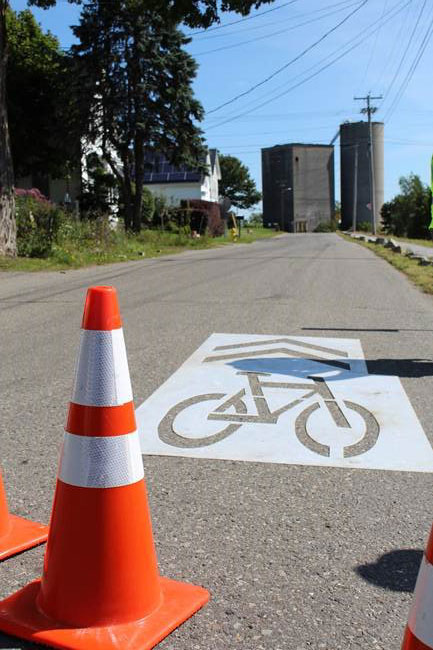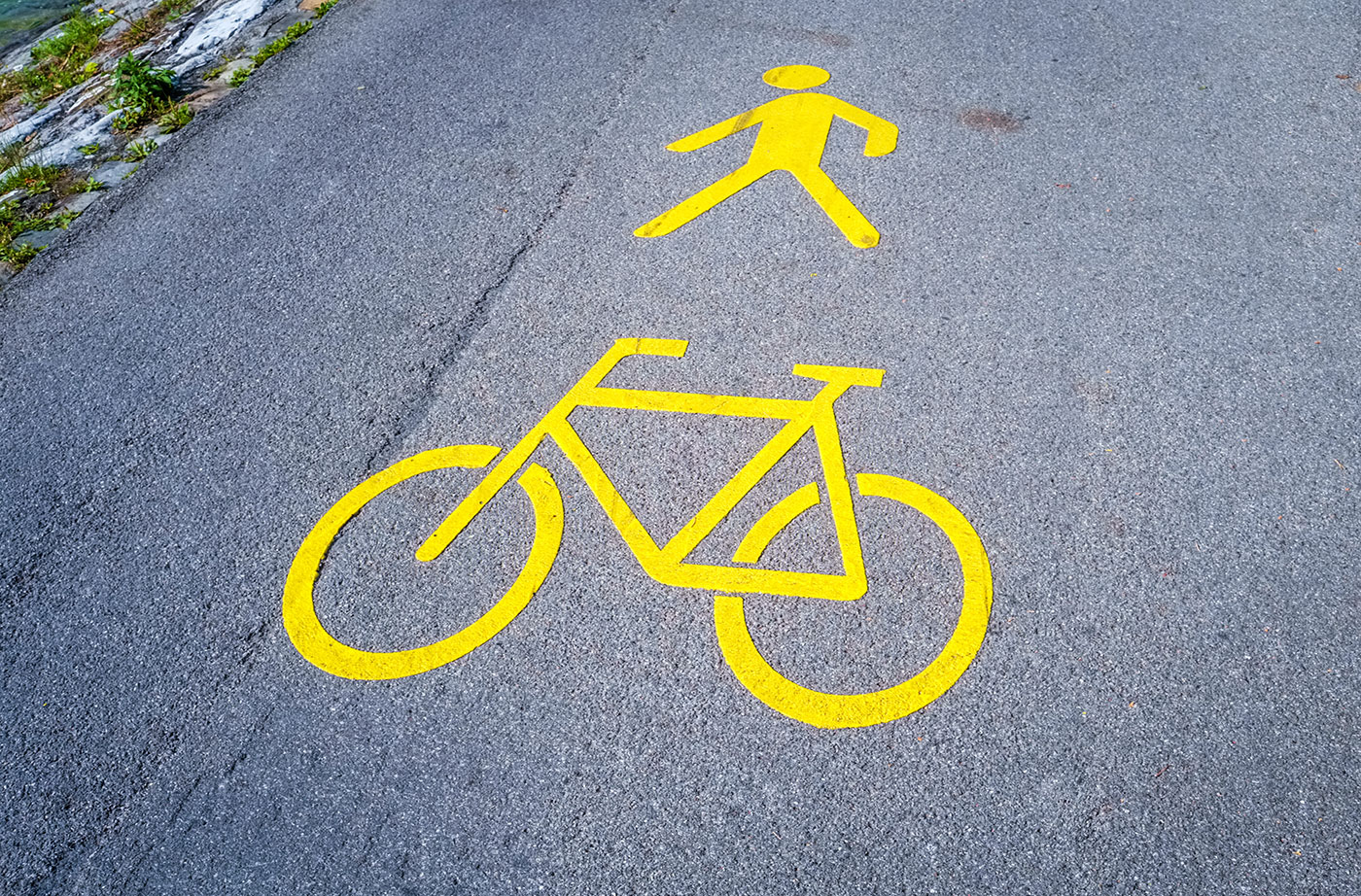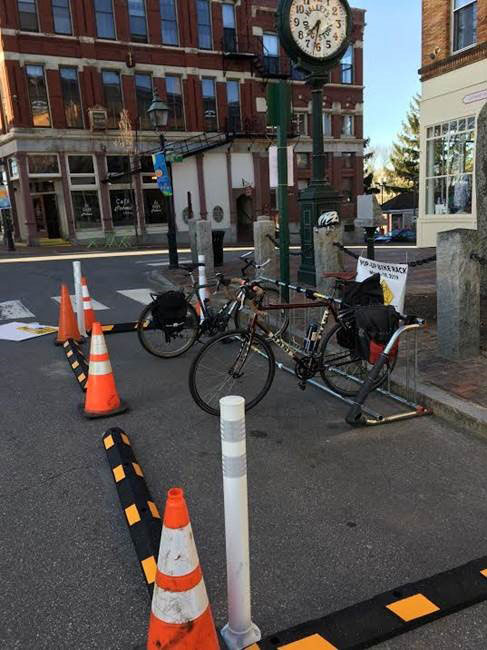As the world grapples with the impact of COVID-19, bicycle and pedestrian advocates across the globe have a tremendous opportunity to prove that clean, human-powered transportation is a viable aspect of an environmentally and economically sustainable future.
The age-old argument against closing streets down to vehicular traffic is “business will suffer if customers are unable to park in front of the stores.” Despite studies that have proven this statement to be inaccurate, our car-dominant culture simply has been unable to let this go. However, COVID-19 is requiring us to think differently about how we get around and shop, providing an opportunity for bicycle and pedestrian advocates to change the tide.

Photo courtesy Bicycle Coalition of Maine
Across the globe, cities are rethinking their streets, creating more space for residents to walk, bike, and run while complying with physical distancing requirements during COVID-19. In the US, cities from San Francisco to Denver to Kansas City to New York City have all closed some streets to vehicle thru-traffic to provide a safer experience for people getting fresh air and exercise. This shift in priority from predominantly motor-vehicle transportation to that of human-centric transportation could be the flip in perspective that bicycle and pedestrian advocates have been waiting for.
Here in Maine, the city of Rockland is considering the closure of their downtown to vehicular traffic this summer. Rockland Main Street Inc. Executive Director David Gogel says, “The idea is not to attract large crowds, but to allow businesses additional space and be able to meet the physical distancing requirement.” Businesses and restaurants would be permitted to use sidewalks to display merchandise and seat customers, respectively.
Similarly, bicycle and pedestrian advocates in Portland are rallying supporters to encourage the City to designate certain traffic corridors as “slow streets” with extra street space dedicated to restaurants, retail, pedestrians, and bicyclists. Reducing vehicle speeds will enable safer recreation and access to businesses. Residential streets designated as “play streets” will mandate slow vehicular speeds and allow more space for families to recreate outdoors without having to leave their neighborhoods. In areas of dense business use, or on other key streets adjacent to parks, the open streets will prioritize non-vehicular traffic such as people walking and biking while allowing continued access to commercial vehicles.

The Bicycle Coalition of Maine believes that streets should be safe for all users. In order to create a more livable and sustainable Maine, we have to think critically about the future of our streets even after the immediate need for more space is met as the result of COVID-19. As we make plans for the future, we should strive for streets full of diverse users and uses; streets that are comfortable not just for motorists, but for all non-vehicular travel, where the air is clean and people of all ages are safe and encouraged to walk and roll for generations to come.
Tackling Transportation Challenges
Transportation makes up 54% of all CO2 emissions in Maine. Of these transportation-related emissions, light-duty passenger cars and trucks produce nearly 60 percent.
The Maine Climate Council (MCC) was formed in 2019 to identify strategies and initiatives to help the state meet its greenhouse gas reduction goals of 45% by 2030 and 80% by 2050. The MCC intends to do this while at the same time working to address mobility and equity issues in a primarily rural state. The Climate Council is made up of 39 members and is supported by the Governor’s Office of Policy Innovation and the Future. These members make up seven subcommittees, also known as working groups.
Jim Tasse of the Bicycle Coalition of Maine is one of four members of the Transportation working group. Thus far, the group has worked to develop strategies for increasing access to public transportation, improving complete streets policies and implementation, encouraging smart growth development, improving bicycle and pedestrian infrastructure to increase connectivity, incentivizing affordable housing in compact development areas, building new schools in walkable areas, and incentivizing e-bikes. All of this work began long before the current global health crisis, but the reality of COVID-19 has highlighted the importance of this work, making these efforts more relevant than ever.
What We’ve Always Known
As bicycle and pedestrian advocates, we know that when the roads feel safe, it encourages more people to walk and bike, making these activities even safer. When cars slow down or when there are fewer cars on the road, more bicyclists and pedestrians can safely use the road. According to the Maine Department of Transportation crash data, the total number of reported crashes in March 2020 was 32.8% lower than in March of 2019. This drop is the result of fewer vehicles being on the road, however, there are some indications cars are driving faster as a result.
Human activity makes places feel vibrant, and seeing folks out walking and bicycling helps us imagine how our roads could be all the time: places for people as well as commerce. Our current situation with COVID-19 could serve as a window into what could be if streets were less dominated by cars. Businesses previously perceived as being dependent on car-centric travel need to rethink how people get to and use their outdoor space in order to follow proper social distancing protocol. These temporary responses to the crisis will become models of future permanent change.

photo courtesy Bicycle Coalition of Maine
As bicycle and pedestrian advocates, let’s take this opportunity to make our voices heard in Maine. Join your local bicycle/pedestrian advocacy group. Join or become a member of trail alliances. Show up to your local planning board meetings. Get involved in legislative efforts. Or, get in touch with the BCM, and we’ll help you get involved. After all, in the words of former NYC Transportation Commissioner Janette Sadik-Khan, “A lot of cities and even countries have been defined by how they’ve responded to historical forces, whether it’s political, social, or physical reconstruction.”
—Guest blog post by Eliza Cress, Bicycle Coalition of Maine











Leave a Reply